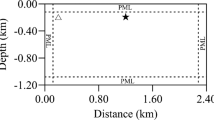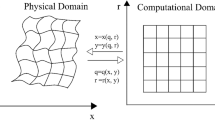Abstract
Edge reflections are inevitable in numerical modeling of seismic wavefields, and they are usually attenuated by absorbing boundary conditions. However, the commonly used perfectly matched layer (PML) boundary condition requires special treatment for the absorbing zone, and in three-dimensional (3D) modeling, it has to split each variable into three corresponding variables, which increases the computing time and memory storage. In contrast, the hybrid absorbing boundary condition (HABC) has the advantages such as ease of implementation, less computation time, and near-perfect absorption; it is thus able to enhance the computational efficiency of 3D elastic wave modeling. In this study, a HABC is developed from two-dimensional (2D) modeling into 3D modeling based on the 1st Higdon one way wave equations, and a HABC is proposed that is suitable for a 3D elastic wave numerical simulation. Numerical simulation results for a homogenous model and a complex model indicate that the proposed HABC method is more effective and has better absorption than the traditional PML method.
Similar content being viewed by others
References
Bécache, E., Fauqueux, S., and Joly P., 2003, Stability of perfectly matched layers, group velocities and anisotropic waves: Journal of Computational Physics, 188(2), 399–433.
Bérenger, J. P., 1994, A perfectly matched layer for the absorption of electromagnetic waves: Journal of Computational Physics, 114(2), 185–200.
Cai, X., Liu, Y., Ren, Z., Wang, J., Chen, Z., Chen, K., and Wang, C., 2015, Three-dimensional acoustic wave equation modeling based on the optimal finite-difference scheme: Applied Geophysics, 12(3), 409–420.
Cerjan, C., Kosloff, D., Kosloff, R., and Resef, M., 1985, A nonreflecting boundary condition for discrete acoustic and elastic wave equations: Geophysics, 50(4), 705–708.
Chang S., and Liu Y., 2013, A truncated implicit highorder finite-difference scheme combined with boundary conditions: Applied Geophysics, 10(1), 53–62.
Chew, W. C., and Weedon, W. H., 1994, A 3-D perfectly matched medium from modified Maxwell’s equations with stretched coordinates: Microwave and Optical Technology Letters, 7(13), 599–604
Chu, C., and Stoffa, P., 2012, Efficient 3D frequency response modeling with spectral accuracy by the rapid expansion method: Geophysics, 77(4), T117–T123.
Clayton, C., and Engquist, B., 1977, Absorbing boundary conditions for acoustic and elastic wave equations: Bulletin of the Seismological Society of America, 67(6), 1529–1540.
Collino, R., and Tsogka, C., 2001, Application of the perfectly matched absorbing layer model to the linear elastodynamic problem in anisotropic heterogeneous media: Geophysics, 66(1), 294–307.
Dong, L., Ma, Z., and Cao, J., 2000, A staggered-grid high-order difference method of one-order elastic wave equation: Chinese Journal of Geophysics, 43(3), 411–419.
Du, Q., Sun, R., Qin, T., Zhu, Y., and Bi, L., 2010, A study of perfectly matched layers for joint multi-component reverse-time migration: Applied Geophysics, 7(2), 166–173.
Festa, G., Delavaud, E., and Vilotte, J. P., 2005, Interaction between surface waves and absorbing boundaries for wave propagation in geological basins: 2D numerical simulations, Geophysics Research Letters, 32(20), 55–102.
Graves, R. W., 1996, Simulating seismic wave propagation in 3D elastic media using staggered-grid finite-difference: Bulletin of the Seismological Society of America, 86(4), 1091–1160.
Heidari, A. H., and Guddati, M. N., 2006, Highly accurate absorbing boundary conditions for wide-angle wave equations: Geophysics, 71(3), S85–S97.
Higdon, R. L., 1991, Absorbing boundary conditions for elastic waves: Geophysics, 56(2), 231–241.
Komatitsch, D., and Martin, R., 2009, An unsplit convolutional perfectly matched layer technique improved at grazing incidence for the viscoelastic wave equation: Geophysics Journal International, 179(1), 146–153.
Komatitsch, D., and Tromp, J., 2003, A perfectly matched layer absorbing boundary condition for the second-order seismic wave equation: Geophysics Journal International, 154(1), 146–153.
Li, Z., Tian, K., Huang, J., Cao, X., Li, N., and Li, Q., 2013, An unsplit implementation of the multi-axial perfectly matched layer: Progress in Geophysics, 28(6), 2984–2992.
Liu, Y., and Sen, M. K., 2009, An implicit staggeredgrid finite-difference method for seismic modeling, Geophysics Journal International, 179(1), 459–474.
Liu, Y., 2014, Optimal staggered-grid finite-difference schemes based on least-squares for wave equation modelling: Geophysical Journal International, 197(2), 1033–1047.
Liu, Y., Li, X., and Chen, S., 2014, Application of the double absorbing boundary condition in seismic modeling: Applied Geophysics, 11(4), 111–119.
Liu, Y., and Sen, M. K., 2010, A hybrid scheme for absorbing edge reflections in numerical modeling of wave propagation: Geophysics, 75(2), A1–A6.
Liu, Y., and Sen, M. K., 2011, 3D acoustic wave modeling with time-space domain dispersion-relation-based finitedifference schemes and hybrid absorbing boundary conditions: Exploration Geophysics, 42(3), 176–189.
Martin, R., Komatitsch, D., and Gedney, S. D., 2008, A variational formulation of stabilized unsplit convolutional perfectly matched layer for the isotropic or anisotropic seismic wave equations: Computing Modeling in Engineering and Science, 37(3), 274–304.
Moczo, P., Kristek, J., and Halada, L., 2000, 3D fourthorder staggered-grid finite-difference schemes: Stability and grid dispersion: Bulletin of the Seismological Society of America, 90(3), 587–603.
Qin, Z., Lu, M., Zheng, X., Yao, Y., Zhang, C., and Song, J., 2009, The implementation of an improved NPML absorbing boundary condition in elastic wave modeling: Applied Geophysics, 6(2), 113–121.
Ren, Z., and Liu, Y., 2013, A hybrid absorbing boundary condition for frequency-domain finite-difference modeling: Journal of Geophysics and Engineering, 10(5), 054003 (16pp).
Ren, Z., and Liu, Y., 2014, Numerical modeling of the first order elastic equations with the hybrid absorbing boundary condition: Chinese Journal of Geophysics, 57(2), 595–606.
Reynolds, A. C., 1978, Boundary conditions for the numerical solution of wave propagation problems: Geophysics, 43(6), 1099–1110.
Sochacki, J., Kubichek, R., George, J., Fletcher, W., and Smithson, S., 1987, Absorbing boundary conditions and surface waves: Geophysics, 52(1), 60–71.
Virieux, J., 1984, SH-wave propagation in heterogeneous media: velocity-stress finite-difference method: Geophysics, 49(11), 1933–1942.
Virieux, J., 1986. P-SV wave propagation in heterogeneous media: velocity stress finite difference method: Geophysics, 51(4), 889–901.
Wang, T., and Tang, X., 2003, Finite-difference modeling of elastic wave propagation: A nonsplitting perfectly matched layer approach: Geophysics, 68(5), 1749–1755.
Zhao, J., and Shi, Q., 2013, Perfectly matched layerabsorbing boundary condition for finite-element timedomain modeling of elastic wave equations: Applied Geophysics, 10(3), 323–326.
Author information
Authors and Affiliations
Corresponding author
Additional information
This research is supported by the National Natural Science Foundation of China (No. 41474110).
Liu Xin, he received a bachelor's degree from China University of Petroleum (Beijing) (2015) and is now a master student in China University of Petroleum (Beijing). His research interests include seismic wave equation numerical modeling and migration.
Rights and permissions
About this article
Cite this article
Liu, X., Liu, Y., Ren, ZM. et al. Hybrid absorbing boundary condition for three-dimensional elastic wave modeling. Appl. Geophys. 14, 270–278 (2017). https://doi.org/10.1007/s11770-017-0623-z
Received:
Revised:
Published:
Issue Date:
DOI: https://doi.org/10.1007/s11770-017-0623-z




